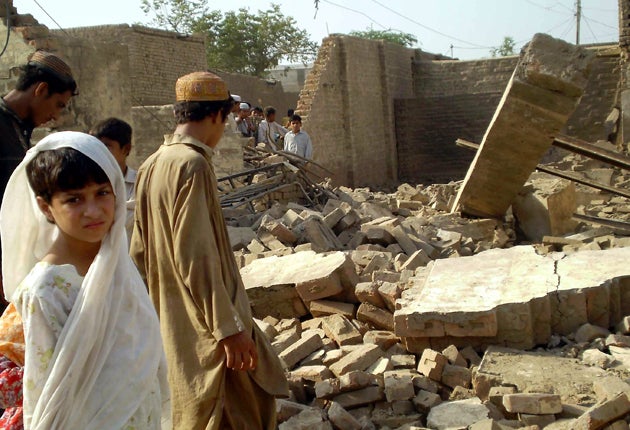Drones: silent killers, or a vital source of information against the Taliban?
The Army says unmanned planes are invaluable in fighting a shadowy enemy. But are too many civilians dying?

The black-and-white footage was grainy and indistinct, but you could make out two men dragging a body along a scrubby field under the direction of a third standing on a mud bank and wearing a dark turban.
These were Taliban fighters attempting to dispose of the corpse of a fallen Afghan soldier near Gereshk in the volatile Helmand province and the scene was being streamed in real-time by an unmanned British drone to a UK command centre at Camp Bastion, also in Helmand province. It was on a subsequent mission to recover that body that a member of the British forces, Private Jason Williams, lost his life last weekend.
While one Hermes 450 unmanned aerial vehicle (UAV) filmed the movements of these Taliban fighters, another aircraft was hovering above what appeared to be a freshly dug hole in the road, possible indicating a recently buried roadside bomb outside the provincial capital of Lashkar Gah.
As the insurgents' bombs exact an increasingly devastating toll on the lives of British, Nato and Afghan troops (Private Williams was the 196th British fatality), these drones are being used more and more to try to get more informed glimpses into the shadowy world of the Taliban.
The UAVS are flown out of Camp Bastion in support of military missions. Flying at 7,000ft, unseen and unheard, they can spy on people burying devices on the ground and track disturbed earth. The information gathered is then passed on to commanders on the ground who decide what to do with it.
The Taliban is increasingly launching ground-to-air attacks – a Ukrainian helicopter under contract to Nato was shot down recently killing six crew. By using unmanned aircraft, the risks are considerably reduced.
However, the use of drones in the conflict spreading across Afghanistan and Pakistan has stoked controversy. Although a number of senior insurgent commanders had been executed by the so-called "silent killers" (the latest being Baitullah Mehsud, the leader of the Pakistani Taliban), there have been repeated complaints that these strikes have also killed civilians, most often the families of the targets.
Doubts have been raised over the policy from a number of quarters. Lord Bingham, a former senior Law Lord, has questioned the legality of such attacks. Lieutenant Colonel David Kilcullen, an Australian Army officer who advised the American General David Petraeus in Iraq and is helping to shape the US policy for Afghanistan, warned that Nato risked losing public support among both Afghans and Pakistanis.
The drones used by the UK from Camp Bastion – the Hermes 450 and Desert Hawk III – are unarmed and are used instead for intelligence gathering. However, the information they glean can have devastating consequences.
This week, one piece of footage showed a group of men near Gereshk burying a device, said to be a bomb, while a lookout kept watch. The details were passed to Nato commanders and, a few minutes later, a US F16 warplane struck with canon fire. Three of the men on the ground were seen to disappear in the explosion, another hid in a field, and the last ran a quarter of a mile to seek refuge in a nearby hamlet, all the while tailed by the drone's camera.
The UAV handlers state that diligent procedures are followed in identifying targets. Captain Giles O'Sullivan-Wade, of 12th Regiment, Royal Artillery, the officer in charge of the unit, stressed: "We have to watch out for any sign of women or children being present, or, indeed, males who are not involved in the suspicious activities.
"I warn the commander that any military action may lead to civilian casualties and would not be justified," he added. "We have to be very, very careful. We have analysed shadows cast on the ground to see whether any of the suspects we are tracking are children."
Sergeant Dean Mitchisson, of 32th Regiment, Royal Artillery, explained: "The rules of engagement are very strict and if I breach them then I would be legally culpable. These things can help a lot in counter-insurgency, but we have to operate under the rules and we have to leave decisions to commanders on the ground."
Both the men say the utmost care must be taken in using armed drones. "There is a danger that you become judge, jury and executioner, and one has to be very, very careful about the rules governing that," said Captain O'Sullivan-Wade.
The Hermes, which is just under 5ft long, costs around £1.5m to manufacture. The Desert Hawk III, which, at around 18in is little bigger than a model airplane, costs around £10,000 and is normally flown at around 300ft.
"We haven't had any of them shot down yet," said Captain O'Sullivan-Wade. "The Hermes flies too high and can't be heard, and the Desert Hawk is so small it looks like a bird."
Join our commenting forum
Join thought-provoking conversations, follow other Independent readers and see their replies
Comments
Bookmark popover
Removed from bookmarks